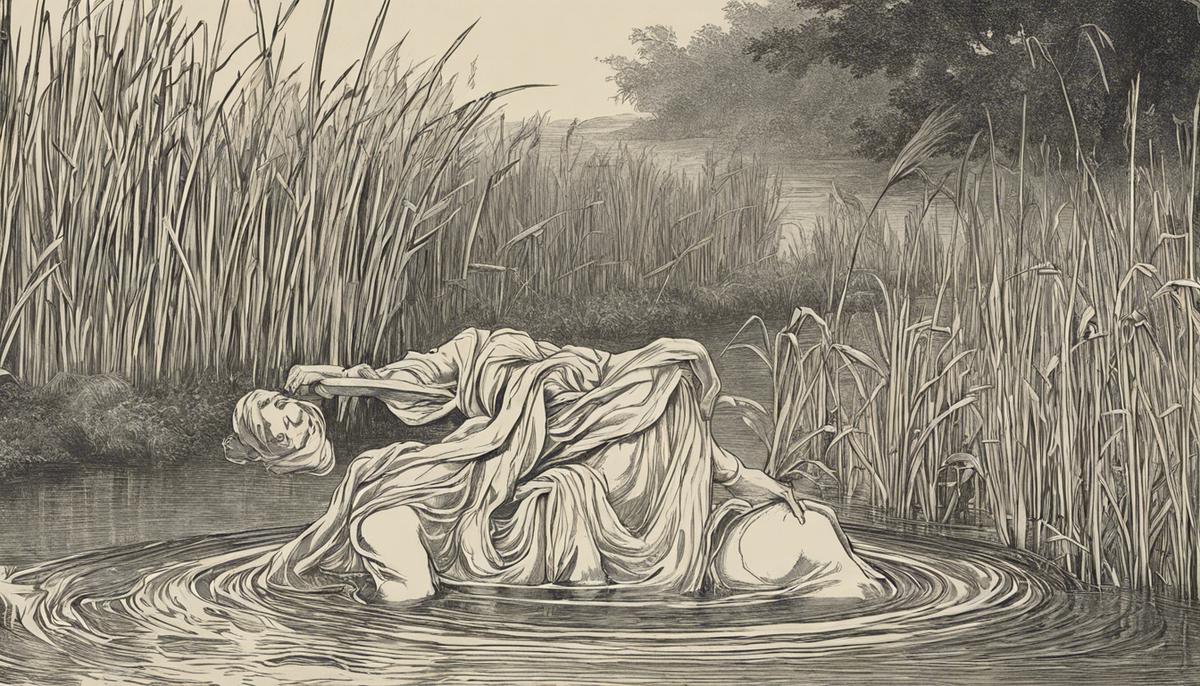Identity of Syrinx
Syrinx, a captivating wood nymph in Greek mythology, is renowned for her connection to Pan, the god of the wilderness. She symbolizes nature's beauty and freedom, like the rustling of reeds along riverbanks.
Their story begins with Pan chasing Syrinx through the woods, smitten by her charm. This pursuit reflects the typical fears about women's autonomy in ancient times, with Syrinx fighting against possession. When cornered by the river, she transforms into reeds, escaping potential capture. From these reeds, Pan creates his iconic panpipes, playing melodies that echo his lost love's whispers.
Syrinx's transformation into both a utilitarian and artistic object captures her significance in the grander mythos. Depictions often showcase her metamorphosis, serving as a reminder of impermanence and art born from denied autonomy.
Her persona amplifies the witty and subversive undercurrents of these narratives. Her escape from Pan illustrates resilience, turning constraint into a new mode of existence. In artwork, she is immortalized at that pivotal moment of transformation, symbolizing an eternal resistance against objectification.
The essence of Syrinx continues to resonate, giving voice to the wind's music and posing reminders of identity's fluidity against confinement. Her legend, with its nuance and allegory, not only decorates ancient contexts but provides a timeless message of liberty personified in mythic relief.

Myth of Pan and Syrinx
The myth of Pan and Syrinx explores desire and boundaries, themes that echo throughout Greek mythology. Pan, embodying the untamed wild, becomes enamored with Syrinx, a nymph as elusive as the wind. His infatuation sparks a spirited chase, representing the clash between possession and freedom.
Imagine the heavy panting and crunching leaves as Pan pursues Syrinx through the underbrush of Arcadia. It's more than a physical chase—it symbolizes a profound battle between domination and sovereignty, an eternal dance beneath ancient boughs.
At the chase's climax, divine intervention ushers Syrinx's transformation into hollow reeds at the river's edge, her final pledge to purity. This twist bridges the divine with the earthly, illustrating that even gods must reckon with nature's immutable laws. Pan's realization that he can only grasp reeds amplifies the tale's tragic undertone, and from his mournful breath emerges the first notes of the Pan flute.
This tale is an ode to the resignation to fate—a farewell to unrequited love and the birth of an artistic marvel. It also sparks introspection:
- What boundaries separate desire from love?
- Can art, manifesting from loss, create a relic more poignant than its original pursuit?
The myth also offers educational context, highlighting the consequences of unchecked desires and celebrating individual identity. It asserts that personal integrity resonates loudly against prevailing winds.
Ultimately, this narrative does more than etch woodland misadventures into minds—it reminds us that every loss holds a potent force, capable of conjuring abiding beauty. It unveils the unyielding power of personal autonomy and illustrates how transcendent beauties woven into mythology can still ripple across the present.

Cultural Impact
The myth of Syrinx extends beyond ancient vases and groves, leaving its mark on a broad spectrum of artistic territories. From poetry to music, Syrinx's tale whispers a throbbing echo into various facets of human expression.
One of the most tangible testaments to Syrinx's enduring legacy is found in classical music. Claude Debussy's seminal composition, "Syrinx," epitomizes her evocative myth. Composed for solo flute, this piece serenely captures Syrinx's elusiveness and tragic grace. Debussy's melodies flow like water, transforming notes into a lament that's both an aesthetic abstraction and an intimate narrative monologue, bridging back to the reeds from which Pan's flute was created.1
In the poetic realm, Syrinx's fate to morph into something alluring yet forgotten finds roots. Rainer Maria Rilke, in "Sonnets to Orpheus," invokes her transformation not as an end but as an unstoppable process—materializing through sound where silence once sat profound. Each poetic element serves as a sinew of tragedy and disillusion.2
In literature, Syrinx's resonance twirls throughout modern sylph-like characters embodying the struggle between freedom and restraint, akin to Virginia Woolf's 'The Waves.' Characters grapple with fluid identities, echoing Syrinx's escape by turning into something elemental. Similarly, themes intertwined within Sarah Ruhl's plays explore transformation and personal autonomy.3
As contemporary culture thrives on reiterations melded into new forms, Syrinx survives through vivid brush-strokes painting escapes and empathetic lines giving voice to silent reeds. Motion pictures delight in weaving subtle and varied interpretations, with undercurrents of Syrinx's influence wafting through sequences reflecting ongoing struggles encapsulated in cinematic art.
Even in our hectic throng of digital beats and literary inventions, Syrinx dances—a lasting allure persisting through each invocation of her being. With each resurrection of her myth, Syrinx offers a subtle act of resilience, crafting an artistic beacon alive across tragedies and times within culture's eternal river. As audiences immerse into diverse renditions of this ancient story, they absorb flourishes from a time when gods intervened in mortal quandaries and narratives turned into life-sustaining art – echoing, grappling, escaping.

Symbolism and Interpretation
For those enrapt in Greek mythology, Syrinx represents not just nature and chasteness, but a symbol woven into the roots of cultural and existential dialogues. Her embodiment as the reed instruments of transformation is a cornerstone elucidative of both womanhood and natural entities in ancient Greek perceptions.
Syrinx's essence, rooted in chastity, portrays a recognizable theme within mythology; her pursuit by Pan shows the tension between preserving and succumbing. This element strides into broader reflections on women's autonomy: enshrined and guarded, yet persistently pursued by external desires. Syrinx's transformation into whispering reeds can be seen as both a surrender to nature's cycles and an assertive defense of personal integrity against overtaking forces.
Syrinx exudes an intrinsic purity aligned with raw wilderness. The rippling brooks and hollow sighs of windswept reeds denote physical landscapes and breathe into Greek's admiration of nature. As reeds represent versatility and resilience against aggressive winds, so does Syrinx in her determined stand against unwanted suitors.
In her failure to escape total possession—her metamorphosis into something the Greeks physically mold through Pan's pipes—we find mirrored human realizations: no being entirely untamed remains free from transformable influences. This seals a reflection on captivity: To what extent is transformation a grip on identity or succumbing to another's narrative? For the Greeks, tales like Syrinx's police the perpetual oscillation between liberty and its elemental vulnerabilities.
Echoing through every syllable of Syrinx is a story resting on profound underpinnings about womanhood projected against panoramic tracts of wild nature. This ponders dilemmas personified by women in ancient Greek society—celebrated and paradoxically confined. The implications spun around her figure command a deeper quest for understanding narratives straddling between cherished freedom and tragic entrapment. A statuesque enigma, liberties intertwine—where freedom sings beauty and tragedy rails against unseen bindings—a symphonic tradition lacing through history.

Comparative Mythology
Dissecting Syrinx's tale within the canvas of comparative mythology, particularly against other cultures' embrace of nature spirits or nymph-like entities, engages a fascinating discourse across mythologies. Syrinx symbolizes both an emblem of nature and a poignant narrative on autonomy and transformation. Her threads align with, yet diverge from, similar mythologies worldwide.
Japanese folklore's spirits, known as kodama, resonate as protective essences of trees, echoing the preservation tied to natural entities, like Syrinx. However, while Syrinx's tale is steeped in intersexual dynamics and boundary defiance—being chased by Pan—it is the subtle discretion in her transformation that stands apart from kodama. The latter are associated with uncanny reverberations in ancient forests but not attributed to tales of escape or identity preservation. Thus, the emotional avenues sang by Syrinx provide a robust theatricality that kodama do not explicitly echo.
In Polynesian lore, entities like Pele, the Hawaiian goddess of volcanoes, share raw elemental ties with nature, akin to Syrinx's affiliation with reed-grass. But Pele's mythos harks more on creation and destructive power rather than passive resistance and chastity. Pele's control over her fiery domain stands starkly against the protective whisper of reeds surrounding Syrinx, reflecting contrasting societal gender expectancies and portrayals of feminine power.
Nordic tales of the Huldra suggest other layers. Like Syrinx, these sylvan entities appear to champions, bearing charisma intertwined with natural backdrops. However, Huldra stories are laden with motifs of seduction and moral twisting, employing cunning—distant from the innocence marking Syrinx's story. This delineates varying semblances across cultures about naturebound female entities.
Comparative mythology here enriches understanding of how folklores cascade meanings upon similar concepts yet morph these idols through distinct societal fabrics. Whether through crisis-themed lore, like Syrinx's transformation, or vilification within other narratives, these myths contribute insights into how cultures universally, yet irregularly, draw faces over nature and its spirit portraits.
Embarking on comparative studies illuminates shared roots, conceptual disparities, and overarching psychological schemas underlying human interactions with the "natural" both symbolically and tangibly. As mythical narratives interplay under societal scripts, what unfolds is a panorama pooling into our intrinsic yearnings, woes, and domains of dominion over nature's constructs—as complexly textured as the paths surrounding Syrinx herself.
In the reflections of Syrinx's story, perhaps the most resonant is the reminder of the power of personal autonomy against overwhelming forces. This theme, woven through the narrative with subtlety and strength, underscores the timeless relevance of Greek mythology in our contemporary quest for identity and freedom.
- Debussy C. Syrinx, for Solo Flute. Paris: Jobert; 1913.
- Rilke RM. Sonnets to Orpheus. Trans. Young D. Middletown: Wesleyan University Press; 1987.
- Ruhl S. Eurydice. New York: Samuel French; 2003.

Leave a Reply